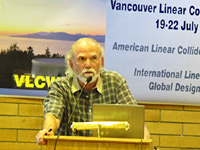Director's Corner
3 August 2006
 Barry Barish presenting his closing plenary talk at VLCW06. |
Reflections on VLCW06: Physics and Detectors
The University of British Columbia, located in beautiful Vancouver, was the venue of a joint American Linear Collider Planning Group (ALCPG) and GDE workshop, attended by 300 participants from 19-23 July. The programme ranged from very practical issues such as cost estimates for the ILC to discussions of the latest theoretical developments in the field. Such a broad programme is the result of our concerted efforts to bring ILC detector/physics and accelerator communities closer together. Holding joint meetings enables us to inform each other and to work together on problems of mutual interest, like the joint science performance of the accelerator and detectors.
 Jack Gunion reviewed ILC Terascale Physics at VLCW06. The figure above shows how the ILC could obtain a clean signal for a 150 GeV Higgs Boson, using event reconstruction of e+e- → H+Z → W+W-Z, where the Z decays to lepton pairs (from Abia, Lohmann and Respereza). |
Fermilab’s Joe Lykken kicked off VLCW06 by giving his version of the physics case for the ILC -- first in one slide, then in three slides, and finally in 24 slides. He refrained from giving his 850 slide version, and instead we heard more in-depth physics discussions in the ALCPG plenary sessions, including Terascale physics, precision measurements, connections to the LHC and even cosmology.
The ILC physics and detector communities will create a “Detector Concept Report” (DCR) that will describe the physics motivation and capabilities of the ILC. It will include chapters on the detector concepts, technologies and associated R&D programme needed to bring the experimental program to reality. Our idea is that the DCR will be a companion piece to the Reference Design Report (RDR) that the GDE is developing for the accelerator project. This pair of reports is scheduled to be released early next year, and together they will present the entire project.
In our ongoing efforts to bring our two communities closer together, we held a number of special joint meetings. These included meetings on the beam delivery systems, the contents and plans for the RDR and DCR and costing methodology. During the workshop there were also joint plenary sessions and a town meeting that consisted of a panel made up of members of both the GDE and the detector community who answered questions from the assembled attendees.
VLCW06 was a very stimulating and useful workshop. My only personal frustration was being confronted with choosing between the many inviting parallel talks.
-- Barry Barish